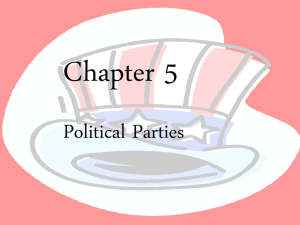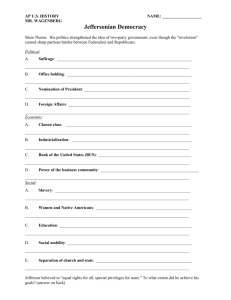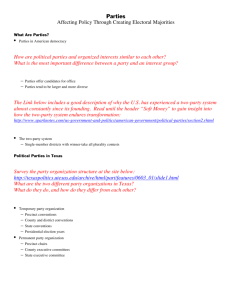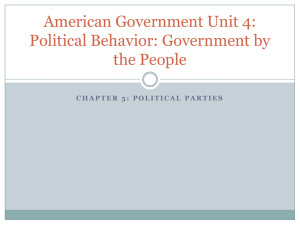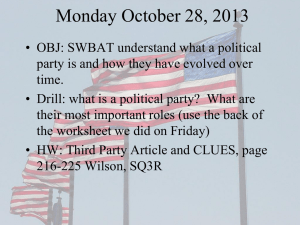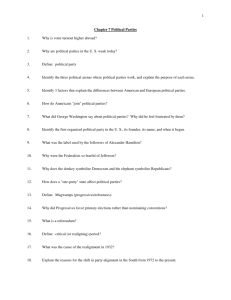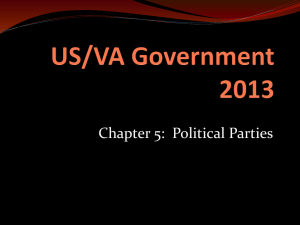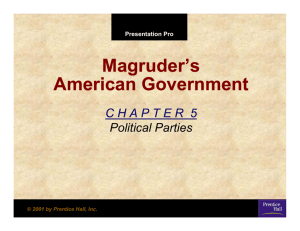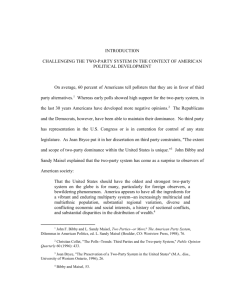Political Parties - Ector County Independent School District
advertisement
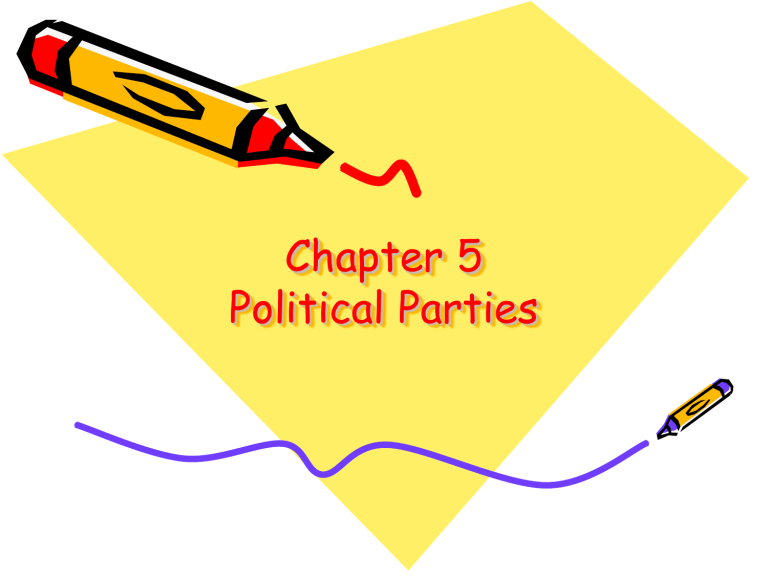
Chapter 5 Political Parties Section 1—Parties and What They Do • Objectives: – Define a Political Party – Describe the major functions of political parties Section 1—Parties and What They Do • Why It Matters: – Political parties are essential to democratic government. In the United States, political parties have shaped the way the government works. Today, the major political parties perform several important functions without which our government could not function. Section 1—Parties and What They Do • Political Dictionary: – – – – Political party Major parties Partisanship Party in power Section 1—Parties and What They Do • What is a political party? – Some are “issue” or “principle” oriented – Some are oriented toward winning elections. • What Do Parties Do? – They are the medium for presenting opinions to the people. – They are a link between the governed and those who govern. – They work to blunt conflicts—Power Brokers Section 1—Parties and What They Do • What Do Parties Do? (cont.) – Nominating Candidates (recruiting and choosing) – Informing and Activating Supporters – The Bonding Agent Function (screening) – Governing—”partisanship” – Acting as Watchdog • “ins and “outs” • Loyal Opposition Section 2—The TwoParty System Section 2—The TwoParty System • Objectives: – Identify the reasons why the United States has a two-party system. – Understand multiparty and one-party systems and how they affect the functioning of government. – Describe party membership patterns in the United States. Section 2—The TwoParty System • Why It Matters: – The two-party system in the United States is a product of historical forces, our electoral system, and the ideological consensus of the American people. It provides more political stability than a multiparty system and more choice than a one-party system. Section 2—The TwoParty System • Political Dictionary: – Minor party – Two-party system – Single-member district – Plurality – Bipartisanship – – – – – Pluralistic society Consensus Multiparty Coalition One-party system Section 2—The TwoParty System • Earl Dodge: six time presidential candidate • Why a Two-Party System? – Regional one-party presence at times – The Historical Basis • Federalists and anti-federalists • Hamilton vs. Jefferson • Washington: warned against “the baneful effects of the spirit of party.” Section 2—The TwoParty System • Why a Two-Party System? (cont.) – The Force of Tradition • Long acceptance “that is just the way it is.” – The Electoral System • Single-member districts • Plurality—largest number of votes cast • Bipartisan nature discourages minor parties – Non-major party candidates in only 7 elections Section 2—The TwoParty System • Why a Two-Party System (cont.) – The American Ideological Consensus • Pluralistic Society—many cultures and groups • Consensus—on most fundamental matters • Middle-of-the-road tendency Section 2—The TwoParty System • Multiparty Systems – Many European nations – Must build coalitions • One-Party Systems – Really no-party – 1/3 of the States are mostly one-party Section 2—The TwoParty System • Party Membership Patterns – Cross section – Democrats—African Americans, Catholics, Jews, Union members, etc. – Republicans—white males, Protestants, business community, etc. – Disrupting events can change patterns: • Civil War • Great Depression Section 3—The Two-Party System in American History • Objectives: – Understand the origins of political parties in the United States. – Identify and describe the three major periods of single-party domination and describe the current era of divided government. Section 3—The Two-Party System in American History • Why It Matters: – The origins and history of political parties in the United States help explain how the two major parties work today and how the affect American government. Section—The Two-Party System in American History • Political Dictionary: – – – – Incumbent Faction Electorate Sectionalism Section 3—The Two-Party System in American History • The Nation’s First Parties – Federalist—Alexander Hamilton – Anti-Federalists under Thomas Jefferson. Became Jeffersonian Republicans; later Democratic Republicans; and then Democrats. – Jefferson defeated the incumbent Adams in 1800. Section 3—The Two-Party System in American History • American Parties: Four Major Eras – The Era of the Democrats, 1800-1860 • • • • • • • Federalists disappear by 1816 Era of Good Feelings Split into factions National Republican party (Whigs) emerges Whigs fall apart Democrats split into North and South 1856 the Republicans emerge from previous Whigs and some Democrats. Section 3—The Two-Party System in American History • American Parties: Four Major Eras – The Era of the Republicans, 1860-1932 • Democrats held the “Solid South.” • McKinley’s victory in 1896 solidified party • Only interruptions were Cleveland and Wilson Section 3—The Two-Party System in American History • American Parties: Four Major Eras – The Return of the Democrats, 19321968 • Great Depression/Roosevelt • Social Welfare programs/New Deal – The Start of a New Era, 1968-2005 • Divided government Section 4—The Minor Parties • Minor Parties in the United States – Ideological Parties • Socialist, Socialist Labor, Socialist Worker, and Communist. • Libertarian – Single Issue Parties • Free Soil—opposed slavery • American or Know Nothing Party—opposed Irish immigration. • Right to Life Party—opposes abortion Section 4—The Minor Parties • Minor Parties in the United States – Economic Protest Parties • Greenback Party • Populist Party of the 1890s – Splinter Parties • • • • • Bull Moose Party of 1912 LaFollette’s Progressive Party States’ Rights (Dixiecrats) American Independent Party of George Wallace Green Party with Ralph Nader Section 4—The Minor Parties • Why Minor Parties Are Important – Anti Masonic Party had first convention in 1831. – Spoiler role of Teddy Roosevelt, Ralph Nader and Ross Perot – They highlight important issues • Income tax, women’s rights, voting Section 5—Party Organization • Objectives: – Understand why the major parties have a decentralized structure. – Describe the national party machinery and how parties are organized at the State and local levels. – Identify the three components of the parties. – Examine the future of the major parties. Section 5—Party Organization • Why It Matters: – The major parties of the United States have a decentralized structure, and the different parts and elements work together primarily during national elections. The parties themselves have been in decline, or losing influence, since the 1960s. Section 5—Party Organization • Political Dictionary: – Ward – Precinct – Split-ticket voting Section 5—Party Organization • The Decentralized Nature of the Parties. – The Role of the Presidency – The Impact of Federalism • Over 500,000 elective offices in America – The Role of the Nominating Process Section 5—Party Organization • National Party Machinery – – – – The National Convention The National Committee The National Chairperson The Congressional Campaign Committees Section 5—Party Organization • State and Local Party Machinery – The State Organization – Local Organization • Wards • Precinct Section 5—Party Organization • The Three Components of the Party – The party organization-leaders, activists, contributors, hanger’s on – The party in the electorate-loyal voters – The party in government-officeholders Section 5—Party Organization • The Future of the Major Parties – Decline in party “identification.” – Increase in split-ticket voting – Open reforms have led to internal conflict and disorganization. – Changes in technology – Growth of single-issue organizations
